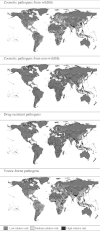Health systems' "surge capacity": state of the art and priorities for future research
- PMID: 23488712
- PMCID: PMC3607127
- DOI: 10.1111/milq.12003
Health systems' "surge capacity": state of the art and priorities for future research
Abstract
Context: Over the past decade, a number of high-impact natural hazard events, together with the increased recognition of pandemic risks, have intensified interest in health systems' ability to prepare for, and cope with, "surges" (sudden large-scale escalations) in treatment needs. In this article, we identify key concepts and components associated with this emerging research theme. We consider the requirements for a standardized conceptual framework for future research capable of informing policy to reduce the morbidity and mortality impacts of such incidents. Here our objective is to appraise the consistency and utility of existing conceptualizations of health systems' surge capacity and their components, with a view to standardizing concepts and measurements to enable future research to generate a cumulative knowledge base for policy and practice.
Methods: A systematic review of the literature on concepts of health systems' surge capacity, with a narrative summary of key concepts relevant to public health.
Findings: The academic literature on surge capacity demonstrates considerable variation in its conceptualization, terms, definitions, and applications. This, together with an absence of detailed and comparable data, has hampered efforts to develop standardized conceptual models, measurements, and metrics. Some degree of consensus is evident for the components of surge capacity, but more work is needed to integrate them. The overwhelming concentration in the United States complicates the generalizability of existing approaches and findings.
Conclusions: The concept of surge capacity is a useful addition to the study of health systems' disaster and/or pandemic planning, mitigation, and response, and it has far-reaching policy implications. Even though research in this area has grown quickly, it has yet to fulfill its potential to generate knowledge to inform policy. Work is needed to generate robust conceptual and analytical frameworks, along with innovations in data collection and methodological approaches that enhance health systems' readiness for, and response to, unpredictable high-consequence surges in demand.
© 2013 Milbank Memorial Fund.
Figures



Similar articles
-
Survivor, family and professional experiences of psychosocial interventions for sexual abuse and violence: a qualitative evidence synthesis.Cochrane Database Syst Rev. 2022 Oct 4;10(10):CD013648. doi: 10.1002/14651858.CD013648.pub2. Cochrane Database Syst Rev. 2022. PMID: 36194890 Free PMC article.
-
Home treatment for mental health problems: a systematic review.Health Technol Assess. 2001;5(15):1-139. doi: 10.3310/hta5150. Health Technol Assess. 2001. PMID: 11532236
-
Developments in Surge Research Priorities: A Systematic Review of the Literature Following the Academic Emergency Medicine Consensus Conference, 2007-2015.Acad Emerg Med. 2015 Nov;22(11):1235-52. doi: 10.1111/acem.12815. Epub 2015 Nov 3. Acad Emerg Med. 2015. PMID: 26531863
-
Ethical Guidance for Disaster Response, Specifically Around Crisis Standards of Care: A Systematic Review.Am J Public Health. 2017 Sep;107(9):e1-e9. doi: 10.2105/AJPH.2017.303882. Epub 2017 Jul 20. Am J Public Health. 2017. PMID: 28727521 Free PMC article.
-
Systemic Inflammatory Response Syndrome.2025 Jun 20. In: StatPearls [Internet]. Treasure Island (FL): StatPearls Publishing; 2025 Jan–. 2025 Jun 20. In: StatPearls [Internet]. Treasure Island (FL): StatPearls Publishing; 2025 Jan–. PMID: 31613449 Free Books & Documents.
Cited by
-
Lessons learned from the COVID-19 response in Sri Lankan hospitals: an interview of frontline healthcare professionals.Front Public Health. 2023 Dec 6;11:1280055. doi: 10.3389/fpubh.2023.1280055. eCollection 2023. Front Public Health. 2023. PMID: 38125853 Free PMC article.
-
Resilience in keeping the balance between demand and capacity in the COVID-19 pandemic, a case study at a Swedish middle-sized hospital.BMC Health Serv Res. 2023 Feb 28;23(1):202. doi: 10.1186/s12913-023-09182-4. BMC Health Serv Res. 2023. PMID: 36855122 Free PMC article.
-
Establishing the Domains of a Hospital Disaster Preparedness Evaluation Tool: A Systematic Review.Prehosp Disaster Med. 2022 Oct;37(5):674-686. doi: 10.1017/S1049023X22001212. Epub 2022 Sep 2. Prehosp Disaster Med. 2022. PMID: 36052843 Free PMC article.
-
Development of a Hospital Medical Surge Preparedness Index using a national hospital survey.Health Serv Outcomes Res Methodol. 2020;20(1):60-83. doi: 10.1007/s10742-020-00208-6. Epub 2020 Feb 14. Health Serv Outcomes Res Methodol. 2020. PMID: 32435150 Free PMC article.
-
US Hospital Capacity Managers' Experiences and Concerns Regarding Preparedness for Seasonal Influenza and Influenza-like Illness.JAMA Netw Open. 2021 Mar 1;4(3):e212382. doi: 10.1001/jamanetworkopen.2021.2382. JAMA Netw Open. 2021. PMID: 33739431 Free PMC article.
References
-
- Ablah E, Nickels D, Hodle A, Wolf DJ. “Public Health Investigation”: Focus Group Study of a Regional Infectious Disease Exercise. Public Health Nursing. 2008;25:546–53. - PubMed
-
- ACEP (American College of Emergency Physicians) Healthcare System Surge Capacity Recognition, Preparedness, and Response. Irving, TX: 2006.
-
- Adini B, Goldberg A, Laor D, Cohen R, Zadok R, Bar-Dayan Y. Assessing Levels of Hospital Emergency Preparedness. Prehospital and Disaster Medicine. 2006;21:451–57. - PubMed
-
- Adisasmito W, Hunter BM, Krumkamp R, Latief K, Rudge JW, Hanvoravongchai P, Coker R. Pandemic Influenza and Health System Resource Gaps in Bali: An Analysis through a Resource Transmission Dynamics Model. Asia Pacific Journal of Public Health. 2011;20:1–21. - PubMed
-
- ADRC (Asian Disaster Reduction Centre) Natural Disaster Data Book 2009: An Analytic Overview. 2009. Kobe.
Publication types
MeSH terms
LinkOut - more resources
Full Text Sources
Other Literature Sources
Medical
Miscellaneous

